#Prehistoric Eocene whale
Text
instagram
Look at this chonker.
Prehistoric whale Perucetus colossus.
Follow @heitoresco on Instagram for more excellent paleoart!
#dinosaurs#dinosaur#paleontology#prehistoric#fossils#paleo art#Perucetus colossus#Prehistoric Eocene whale#heitoresco#Instagram
70 notes
·
View notes
Text
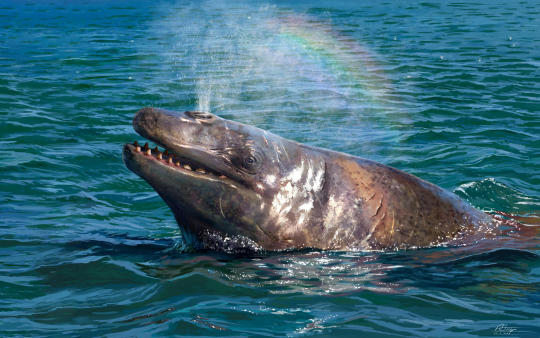
Perucetus colossus by Anthony J. Hutchings.
4K notes
·
View notes
Text

A fossilized tooth of an indeterminate basilosaurid, possibly Basilosaurus isis from the Samlat Formation in Dakhla, Morocco. It is unclear if the larger teeth from these ancient whales can be attributed to Basilosaurus.
#synapsid#mammal#fossils#paleontology#palaeontology#paleo#palaeo#basilosaurus#dorudon#cetacean#whale#eocene#cenozoic#prehistoric#science#paleoblr#fossil friday#fossilfriday#バシロサウルス#ドルドン#クジラ#化石#古生物学
108 notes
·
View notes
Text

Eocene, so familiar yet so different
#paleoart#paleoblr#eocene#cenozoic#prehistoric life#basilosaurus#whale evolution#pelagornis#Ok it's not actually the genus pelagornis but close enough#watercolor#ye I know I got basil's head wrong but still had lots of fun :D
9 notes
·
View notes
Text

Perucetus colossus was an early whale of the basilosaurid family that swam in the oceans of the Eocene epoch between 39 and 37 million years ago. The study describing it estimated its weight as ranging between 94 and 375 tons, which would make it the most massive animal to have ever lived (for comparison, the modern blue whale has a maximum weight under 220 tons). So far, however, only parts of its rib cage and spinal column as well as vestigial hips have been found.
30 notes
·
View notes
Text
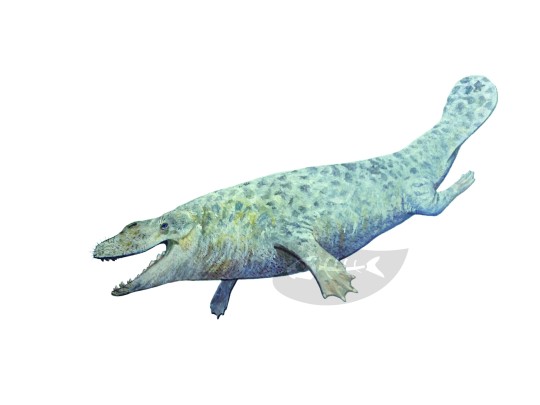
Here's a Pappocetus lugardi while I'm at it. For reference I looked at some Pappocetus specimens from Gueran in the Laâyoune-Sakia El Hamra Region of Morocco and the drawings in the description by Charles William Andrews.
(image ID: A watercolour painting of an early whale with legs and a paddle-like tail.)
#pappocetus#whale#eocene#prehistory#prehistoric#morocco#nigeria#africa#palaeontology#fossil#sciart#watercolour#scientificillustration
1 note
·
View note
Text
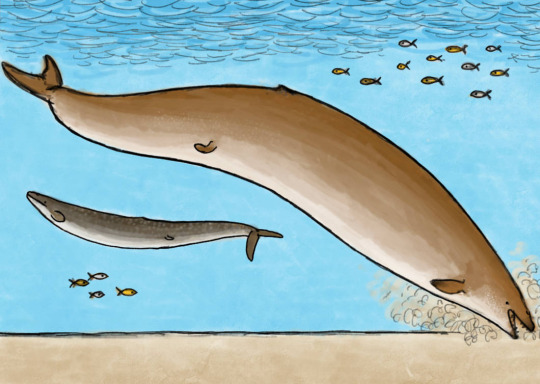
One Whale to Rule Them All: Impression of Perucetus, a giant, possibly mollusk-eating Archaeocete which lived in the Eocene of Peru 39-37 million years ago and is considered a true colossus among early cetaceans. At up to 17-20 meters long and 85-340 tons in weight, Perucetus surpassed Basilosaurus in size as the largest of the basilosaurids, and as possibly one of the largest and heaviest prehistoric sea-creatures ever to have existed.
References:www.nature.com/articles/s41586…
#perucetus#paleontography#paleontology#eocene#cenozoic life#cenozoology#cenozoic#whale#basilosauridae#cetaceans
39 notes
·
View notes
Text
National Fossil: Peru
We‘re continuing our travels through South America and the next stop is Peru.
Once again, you get to vote on which one should represent the nation. As always, it could be a fossil that is just exceptionally well preserved and beautiful, had a huge impact on paleontology and our knowledge of the past, is very common/representative of the area, is beloved and famous in the public eye, is just a very unique and interesting find, or has any other justification.
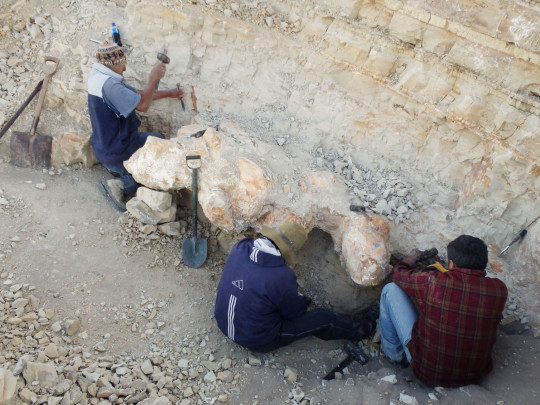

Perucetus: The first contestant has just been described earlier this year. Named after its home country, the giant whale made headlines because it might be the heaviest animal that ever lived, even surpassing the modern blue whale (just keep in mind that this is still very much up for debate as Perucetus‘ estimated size range spans from “just“ 85 t to well over 300 t; Art by Adam Works)
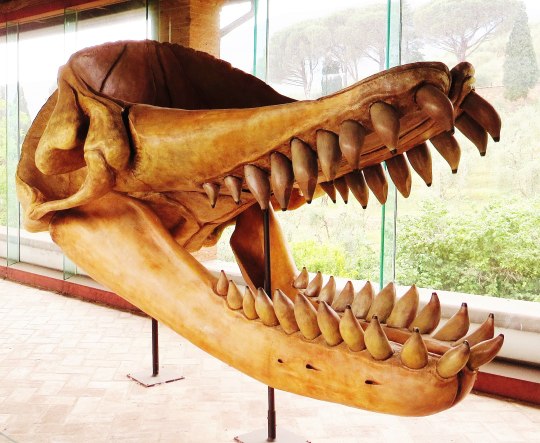

Livyatan: In case one giant whale is not enough, Peru also offers you Livyatan, named after the biblical monster. It was first discovered in Peru, where it lived about 30 million years after Perucetus. It was similar in size to its modern cousin, the sperm whale. (Art by Balasz Petheo)
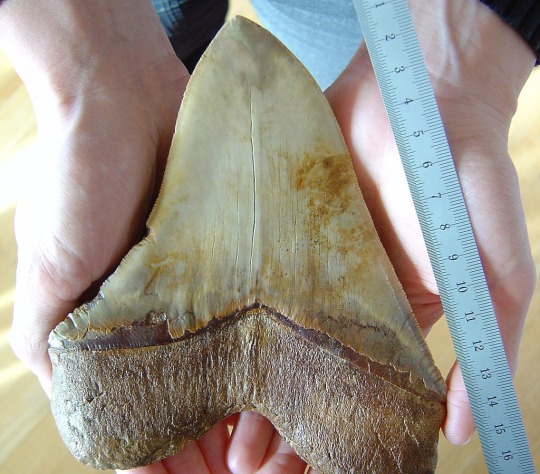

Megalodon: It seems to be an unspoken rule of paleo that you cannot mention Livyatan without pointing out that they shared a habitat and directly competed with megalodon, fighting brutal battles to the death (honestly, they were probably both chill and just stayed out of each others way, but whatever…). Since it had a global distribution, picking megalodon as a National Fossil might be a bit controversial - on the other hand: There have been fossils found in Peru and no other country has claimed the giant shark yet, so this is your chance to call dibs on the famed movie monster.

Inkayacu: Next up is a cute penguin! Well, cute might be the wrong word considering it was almost as tall as me. Inkayacu lived about 35 million years ago during the Eocene (btw great time to be a giant penguin) and is known from very well preserved fossils, including feathers. From the material researcher could even tell its coloration and unlike its modern relatives, Inkayacu was reddish-brown and grey. (Art by Ripley Cook)


Thalassocnus: Ground sloths are among the most iconic prehistoric South American fauna, and this one is not just your regular weird giant ground sloth - it was a semi-aquatic giant ground sloth! There are multiple species of these guys known, all from slightly different ages. They show very well how they transitioned to a more aquatic lifestyle over time, making them a great example for evolution in progress. (Art by Mark Witton)
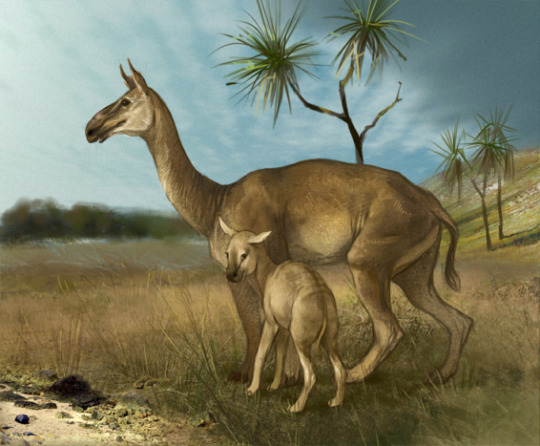
Macrauchenia: Lastly we have the “long llama“ as the name translates. Since today llamas (well, vicunas, but same difference) are Perus national animal, I wanted to give an option that resembles them. Macrauchenia actually belongs to a now extinct line of hoofed mammals that lived in South America back when the continent was still separated from all other land masses. While they weren‘t too closely related to our modern camels and llamas, they probably filled a similar niche. (Art by Olga Kobrina)
#paleobr#paleontology#fossils#peru#perucetus#livyatan#megalodon#penguin#ground sloth#macrauchenia#national fossil
14 notes
·
View notes
Photo







Basilosaurus (meaning "king lizard") is a genus of large, predatory, prehistoric archaeocete whale which lived during the late Eocene, approximately 41 to 33 mya. First described in 1834 from vertebrae, a partial jaw, teeth, a humerus, and rib fragments by Richard Harlan. He originally thought they belonged to a giant aquatic reptile, hence the suffix "-saurus", Ancient Greek for "lizard". The animal was later found to be an archaeocete prehistoric whale, which prompted attempts at renaming the creature, which failed as the rules of zoological nomenclature dictate using the original name given. In 1904 fossils were later found of the second species throughout Egypt, Western Sahara, Morocco, Jordan, Tunisia, and Pakistan. Fossils have also been unearthed in the southeastern United States and Peru. Today there are 2 valid species B. cetoides & B. isis. With B. isis reaching 50-60ft (15- 18m) long & 7 tons (6.5 metric tons) in weight, and B. cetoides reaching 56-66ft (17-20m) long & 6.5 tons (5.8 metric tons) in weight, basilosaurus was one of the largest, if not the largest, animals of the Paleogene one of the largest animals known to exist between the K–Pg extinction event 66 mya and around 15 mya when modern whales began to reach enormous sizes. Although it likely lived around the globe, Basilosaurus was particularly abundant in Tethys Ocean. It was the top predator of its environment, preying on sharks, large fish, sea turtles, crocodilians, and other aquatic mammals, such as the primitive sirenian Protosiren, the early semi aquatic elephant Moeritherium and the dolphin-like Dorudon, the later which of which seems to have been their predominant food source.
Art Belongs to the following creators:
Basilosaurus and Nautilus: Fabienne Brockmanne
https://fabienne-brockmann.tumblr.com/post/156129027671
Basilosaurus Pair: Paleoguy
https://www.deviantart.com/paleoguy/art/Basilosaurus-724513237
Basilosaurus in Ecosystem: Paleoguy
https://www.deviantart.com/paleoguy/art/Basilosaurus-Dorudon-Protosiren-841769431
Basilosaurus: The7thSea
https://www.deviantart.com/the7thsea/art/Basilosaurus-875035699
Basilosaurus with Calf: Gabuded
https://www.deviantart.com/gabuded/art/Basilosaurus-and-Calf-900388020
Basilosaurus Pod: Pavel Riha
https://commons.wikimedia.org/wiki/File:Basilosaurus.jpg
12 notes
·
View notes
Text
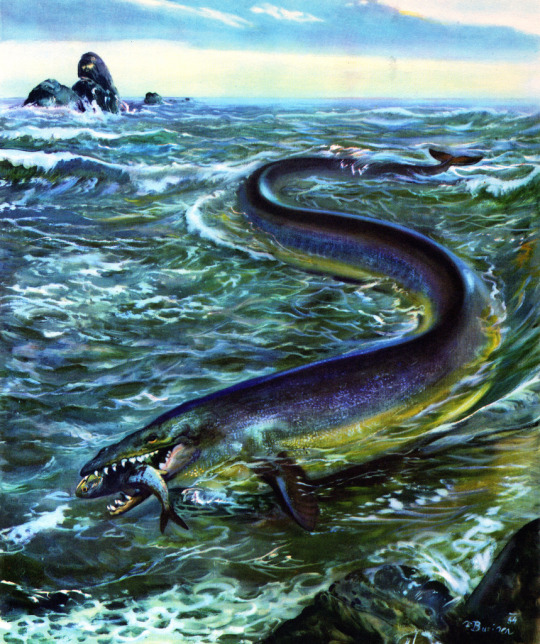



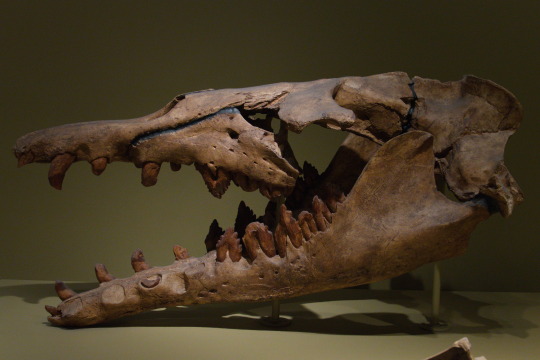

Basilosaurus
(temporal range: 41.3-33.9 mio. years ago)
[text from the Wikipedia article, see also link above]
Basilosaurus (meaning "king lizard") is a genus of large, predatory, prehistoric archaeocete whale from the late Eocene, approximately 41.3 to 33.9 million years ago (mya). First described in 1834, it was the first archaeocete and prehistoric whale known to science.[2] Fossils attributed to the type species B. cetoides were discovered in the United States. They were originally thought to be of a giant reptile, hence the suffix "-saurus", Ancient Greek for "lizard". The animal was later found to be an early marine mammal, which prompted attempts at renaming the creature, which failed as the rules of zoological nomenclature dictate using the original name given. Fossils were later found of the second species, B. isis, in 1904 in Egypt, Western Sahara, Morocco, Jordan, Tunisia, and Pakistan.[3] Fossils have also been unearthed in the southeastern United States and Peru.[4][5][6]
Basilosaurus is thought to have been common in the Tethys Ocean.[7][8] It was one of the largest, if not the largest, animals of the Paleogene. It was the top predator of its environment, preying on sharks, large fish and other marine mammals, namely the dolphin-like Dorudon, which seems to have been their predominant food source.
Basilosaurus was at one point a wastebasket taxon, before the genus slowly started getting reevaluated, with many species of different Eocene cetacean being assigned to the genus in the past, however they are invalid or have been reclassified under a new or different genus, leaving only 2 confirmed species. Basilosaurus may have been one of the first fully aquatic cetaceans[2] (sometimes referred to as the pelagiceti[9]). Basilosaurus, unlike modern cetaceans, had various types of teeth–such as canines and molars–in its mouth (heterodonty), and it probably was able to chew its food in contrast to modern cetaceans which swallow their food whole.
3 notes
·
View notes
Photo

Basilosaurus is an extinct relative of modern whales, reaching lengths from 15-20m and very notable for it's more serpentine anatomy compared to modern whales.
This is a fairly standard reconstruction nowadays, less shrinkwrapped then the older ones.
#my art#paleoart#basilosaurus#whale#extinct#animal#mammal#carnivore#piscivore#eocene#ocean#zeuglodon#nature#cenozoic#prehistoric
1K notes
·
View notes
Photo
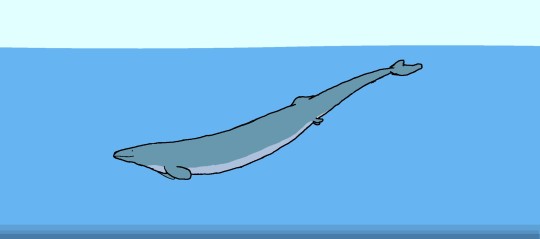
Basilosaurus cetoides
Late Eocene (41-34 Ma)
Bluuughhhhhhh. I forgot the clocks were going to move forward last weekend, and my schedule is completely off-kilter. But after slamming most of a big cup of coffee, I'm here to talk about a really cool whale. The Eocene was a great time to be a mammal. After taking their first shaky steps into the limelight during the Paleocene, mammals took over the world in the Eocene. Whales were among the most immediately successful groups, and Basilosaurus was one of the earliest whales fully adapted for marine life. It had a fusiform body and a powerful fluked tail, with its forelimbs adapted into flippers. They ranged in size from 15-20 meters, making them not only one of the earliest large whales, but possibly the largest animal in the Paleogene period.
It's no secret that I love taxonomy, so let's talk about it!
There are two species of Basilosaurus: The type species, B. cetoides and the slightly smaller B. isis. ‘Basilosaurus’ means ‘King Lizard,’ which is weird because, you know, it’s a whale. It’s called that because its discoverers thought it was some kind of sea serpent thanks to its weird body proportions. After the realization it was a whale, the name Zeuglodon was suggested as a replacement. However, since Basilosaurus was the first name given, it had priority, and Zeuglodon became a junior synonym. It gets wackier. Another junior synonym is Alabamornis. This means 'bird from Alabama,' and was given to what was thought to be a big bird's shoulder bone in 1906, but was actually a pelvis of Basilosaurus. And on the less scientific side of things, in 1845, Dr. Albert Koch unveiled the skeleton of a giant sea serpent he called “Hydrarchos,” which would have been really cool if it wasn't really fake. It was probably two Basilosaurus skeletons stuck together, but we don't know for certain because it was destroyed in 1871 by the great Chicago fire.
Despite looking like a modern whale in many respects, Basilosaurus was still weird. Compared to modern predatory whales, it has a proportionally longer body and neck. Its head was smaller, with no room for a melon (the adorable name for the hearing organ toothed whales have in their foreheads). It had a smaller brain too, and probably wasn’t as social or intelligent as say, an orca. Its flippers also had a functioning elbow joint, like sea lions. It was probably best at swimming in two dimensions near the water’s surface, rather than diving.
Perhaps the strangest thing, though, is its pair of tiny hind limbs and pelvis disconnected from the vertebral column. Some whales today have tiny, vestigial hind limbs, but they're reduced to a few useless bones hidden beneath the skin. Basilosaurus' back legs were recognizable as such, and were used for... something. Maybe holding onto each other while mating, almost certainly not for biking.
This animal was widespread throughout the Tethys sea, the ancient waterway between Gondwana and Laurasia in the Mesozoic. As Africa and Eurasia moved toward each other, it was beginning to split in the Eocene, but it still covered swaths of land in shallow, warm sea. The two species of Basilosaurus have different teeth, and probably fed on different prey. B. cetoides typically ate large fish and sharks. B. isis, though, is known to eat Dorudon, a smaller basilosaurid whale. Specimens of Dorudon have been found with bite marks in the skull, attributed to Basilosaurus, and the damage done to the skeletons around it suggest B. isis hunted by delivering a fatal wound to the head before tearing the body apart with its jaws, which sounds metal as hell.
Basilosaurus has always been a favorite mammal of mine. It has a certain elegance and beauty I've always admired, the first of the cetacean giants. Although I'm not a particularly religious or spiritual person, there's something magical about seeing such a huge animal swimming in open waters. I hope I captured some that mystified feeling with this drawing. I first saw Basilosaurus in the second episode of Walking with Beasts, wherein a pregnant B. isis has to find food at the beginning of a climate crisis. WWB constitutes a good 70% of my Cenozoic knowledge. It probably won't be long before I've drawn every mammal featured in it, and I swear I'm not doing that on purpose. Mammals aren't really my strong suit, especially not whales, but I had a lot of fun drawing this. And part of the point of this blog is to teach myself about groups I otherwise don't really study, so I guess you could say I did a good job of that.
SOURCES
Riley Black, 2009 – The Rise and Fall of Alabamornis
Gingerich, 1998 – Paleobiological Perspectives on Mesonychia, Archaeoceti, and the Origin of Whales
Voss, et al. 2019 – Stomach contents of the archaeocete Basilosaurus isis
******************************************************************************
Buy me a Ko-fi, if you’d like!
#basilosaurus#zeuglodon#whales#cetaceans#mammals#eocene#paleogene#cenozoic#paleoart#palaeoart#paleoblr#palaeoblr#paleontology#palaeontology#prehistoric
29 notes
·
View notes
Photo

Fan art of Paleosteno. He likes paleontology and cetaceans so I combined his two favorite things with a Pakicetus.
#paleosteno#pakicetus#whale#cetacean#eocene#cenozoic#prehistoric#extinct#whale evolution#fan art#youtube fan art#youtuber#youtube#paleo#mammal#artiodactyla#ungulate
20 notes
·
View notes
Photo

Basilosaurus
13 notes
·
View notes
Photo

Basilosaurus cetoides skeleton - 15–20 m (49–66 ft) - Basliosaurus (sometimes called Zeuglodon) was a large, predatory, prehistoric archaeocete whale from the late Eocene, approximately 41.3 to 33.9 million years ago. The Basilosauridae family went extinct at the end of the Eocene, leaving no descendants — modern cetaceans evolved from different land dwelling mammals.
Basilosaurus, unlike modern cetaceans, had various types of teeth – such as canines and molars – in its mouth (heterodonty), and it probably was able to chew its food in contrast to modern cetaceans which swallow their food whole.
Basilosaurus fossils have been found in Arkansas, Alabama, Mississippi, Louisiana, Georgia, Morocco, Egypt, Jordan, Tunisia New Zealand, and Antarctica

82 notes
·
View notes
Text

While the enigmatic Andrewsarchus is a fairly popular prehistoric mammal, much of the identity of this animal remains a mystery.
It is only known from a single skull, though from that it can at least be gathered that it was an artiodactyl (hooved mammal.) One study places Andrewsarchus in Cetancodontamorpha, the clade which includes whales, hippos, and entelodonts, while classically it was placed with the more wolf-like Mesonychians. Like entelodonts, they were probably omnivorous, but seemed to lean more towards predation or scavenging carcasses than digging for roots. Since we only have one massive (three foot long!) skull, it can’t be said for sure, but depending on how its body was built Andrewsarchus could have been the largest predatory land mammal of all time.
It lived in Inner Mongolia during the Eocene, and while Basilosaurus was ruling the seas, it was busy ruling the land.
23 notes
·
View notes